In the spring of 1930 John Frank Alsup was having trouble paying his creditors. Those creditors were complaining to his employer: the Fort Worth police department.
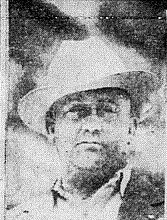 As a result, in March officer John Alsup was fired. Suddenly he had debts, and he had no income. But he did have a plan.
As a result, in March officer John Alsup was fired. Suddenly he had debts, and he had no income. But he did have a plan.

Alsup knew that the Texas Bankers Association had put a price on the head of bank robbers during the Great Depression: a $5,000 ($70,000 today) reward for a dead bank robber. Collecting that reward money would get Alsup out of debt and then some.
But where, oh where, could Alsup find a bank robber to kill?
Why, he’d just hire one! Heck, why not hire two and double the reward: $10,000?


But he’d need help. So, Alsup began to conspire with Augustus Penn Boyt, a barber, and Will Vincent, who worked as a servant on Chase Court. Alsup would pay Vincent, an African-American, to recruit two African-American men to rob the First State Bank of Polytechnic (founded by S. S. Dillow) on Rosedale Street. Boyt, for his share of the reward money, would chauffeur the two robbers to the bank and drive the getaway car after the robbery.
But Alsup planned to make sure there was no getaway.
Meanwhile Vincent dutifully recruited Will Tate and George Terrell to be the dupes to rob the bank, promising them “quick work and easy money.”
 The 1930 city directory shows Avenue F (Rosedale) from Binkley to Vaughn Boulevard. Note that five grocery stores—Wilkerson & Carmichael, A&P, Helpy-Selfy, Piggly Wiggly, and Clarence Saunders—were on the south side of the 3100 block with venerable Burge’s Hardware. The two businesses involved in this story were the bank at 3023 and the Renfro Pharmacy across the street at 3020. The building at 3020 would later house L&H Rexall Drugstore.
The 1930 city directory shows Avenue F (Rosedale) from Binkley to Vaughn Boulevard. Note that five grocery stores—Wilkerson & Carmichael, A&P, Helpy-Selfy, Piggly Wiggly, and Clarence Saunders—were on the south side of the 3100 block with venerable Burge’s Hardware. The two businesses involved in this story were the bank at 3023 and the Renfro Pharmacy across the street at 3020. The building at 3020 would later house L&H Rexall Drugstore.
John Alsup continued to weave his tangled web: He knew that San Angelo Police Chief W. L. Zent was in town. Alsup arranged to meet with Zent and to have Zent talk with Will Vincent. Vincent told Zent that “two bad negro gunmen” planned to rob the Poly bank the next day. Zent suggested to Alsup that Alsup warn Fort Worth Police Chief Henry Lee about the planned robbery. Alsup, no longer being in the good graces of the police force, demurred and suggested instead that Zent tip off Chief Lee.
Chief Lee later testified that the next day he had run into Alsup, who then told Lee that Alsup had been the source of the tip about the planned bank robbery.
“I told him,” Lee recalled, “to go on out there [to guard the bank] and let him have a sawed-off shotgun loaded with buckshot.”
Chief Lee said Alsup, although no longer on the police force, retained his status as a “special officer,” which Alsup had been given during the Stock Show in January before he was discharged in March. This status gave Alsup the same rights as a regular officer.
Police detective J. W. Swinney, who also was assigned to guard the targeted bank, later testified that when Alsup was told how many police officers in addition to Alsup would be guarding the bank, Alsup complained: “If there are that many . . . there won’t be anything in it for any of us.” At the time, police officers were entitled to collect reward money.
At about noon on April 10, barber Boyt drove dupes Tate and Terrell to Poly and let them out of the car near Poly High School (then located on Nashville Avenue) two blocks from the bank.
Waiting inside the bank were police detective Ed Weatherford, perched on top of the bank vault with a shotgun and a pistol, and police detective Swinney. John Alsup was across the street in the drugstore with his sawed-off shotgun and two pistols.
The police had tipped local newspapers about the robbery, and reporters were waiting a half-block away.
Seems that everyone had inside information except Will Tate and George Terrell.
When Tate and Terrell entered the bank, assistant cashier J. M. Fry and vice president E. M. Perkins were sitting in an office.
“Stick ’em up,” one of the robbers demanded of Fry and Perkins. The two bankers raised their hands.
“Where is the money?” the robbers asked.
Fry, knowing that he was well protected by police, pointed to two teller cages behind him. According to the Star-Telegram, Fry said, “If you want the money, you’ll have to come after it.”
The bank had about $15,000 in cash on hand, the Star-Telegram reported.
Then the shooting began.
Detective Weatherford testified that Tate had a gun. Weatherford said he was not sure that Terrell was armed. Predictably, witnesses did not agree on who fired first. Fry said Tate did not fire first. Weatherford said he did not fire first. The Star-Telegram said Alsup, outside the bank, fired the first shot.
Regardless, in the next few seconds, witnesses recalled, Alsup, from outside the bank, fired twenty to twenty-five shots; inside the bank Weatherford fired seven or eight, and the robbers fired six. Weatherford, the Star-Telegram reported, wounded both Tate and Terrell.
Early in the fusillade, banker Fry was shot in the head. The Press reported on April 11 that Fry was hit by buckshot, which apparently was fired by detective Weatherford, struck a filing cabinet, and shattered, a fragment ricocheting into Fry.
Fry would recover to testify.
Perkins was slightly injured by glass fragments as bullets smashed the windows of the bank building.
Wounded, and with bullets flying in the small bank, robbers Tate and Terrell tried to flee from the busted robbery. But as they ran out of the bank door, getaway man Boyt was not there waiting for them. After dropping off Tate and Terrell near the bank, Boyt had driven the “getaway car” back to Arlington Heights and had gone back to work at a barber shop on Camp Bowie Boulevard.
But someone was waiting outside for Tate and Terrell: John Alsup. Alsup also was waiting for that $10,000 reward. From the street Alsup first shot Terrell, who staggered a few paces west and fell dead in a front yard. Tate, still armed, ran north on Annis Street (now Wesleyan Street). Alsup chased Tate on foot but on Annis Street jumped onto the running board of a passing car and continued to shoot at Tate, the Press reported. Alsup caught up with Tate on the steps of Polytechnic Methodist Church, then at the corner of Avenue E and Annis, where, the Press reported, a meeting of the Glad Hand Sunday School class was in session. On the church steps Alsup shot Tate dead.
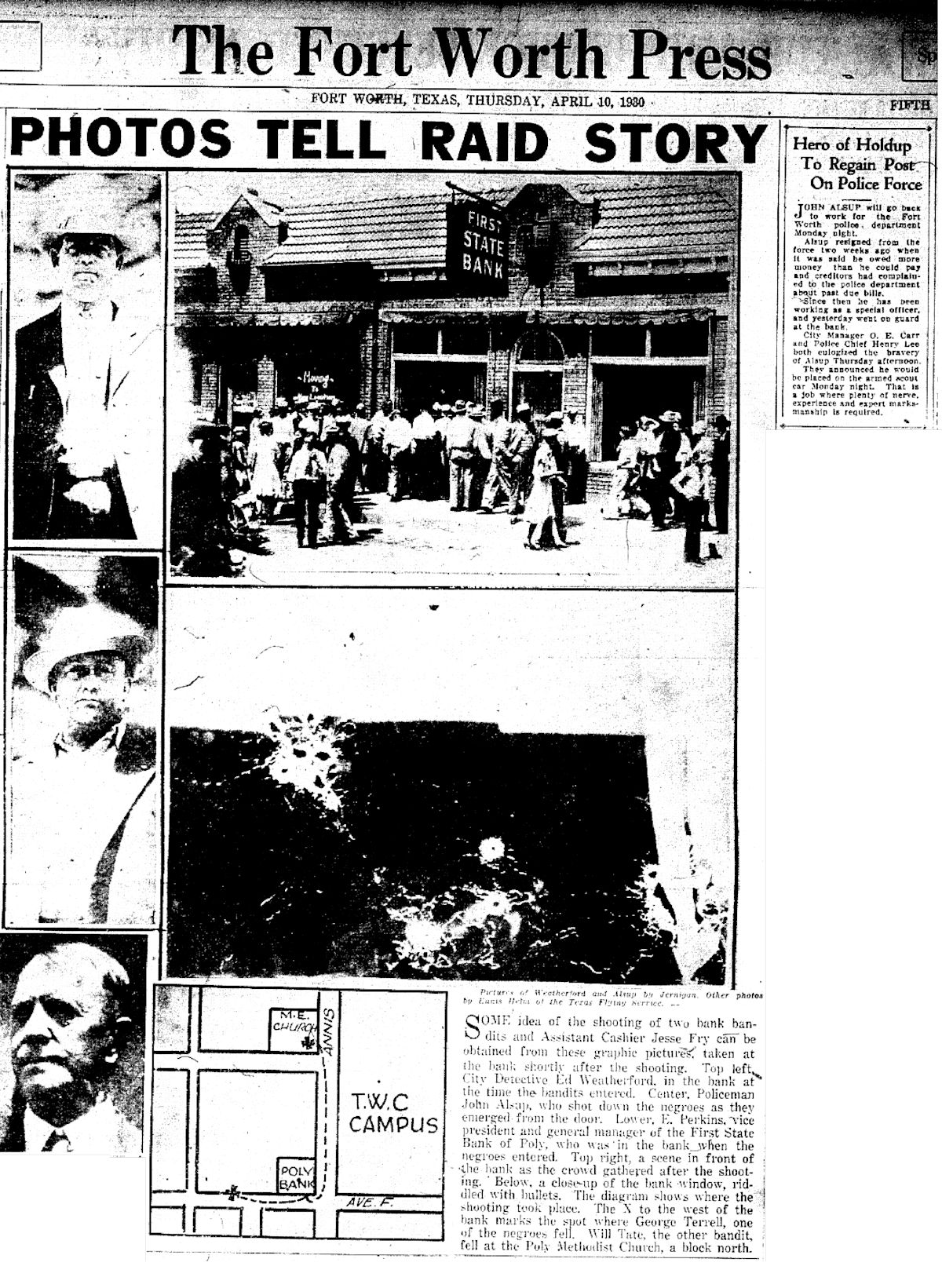
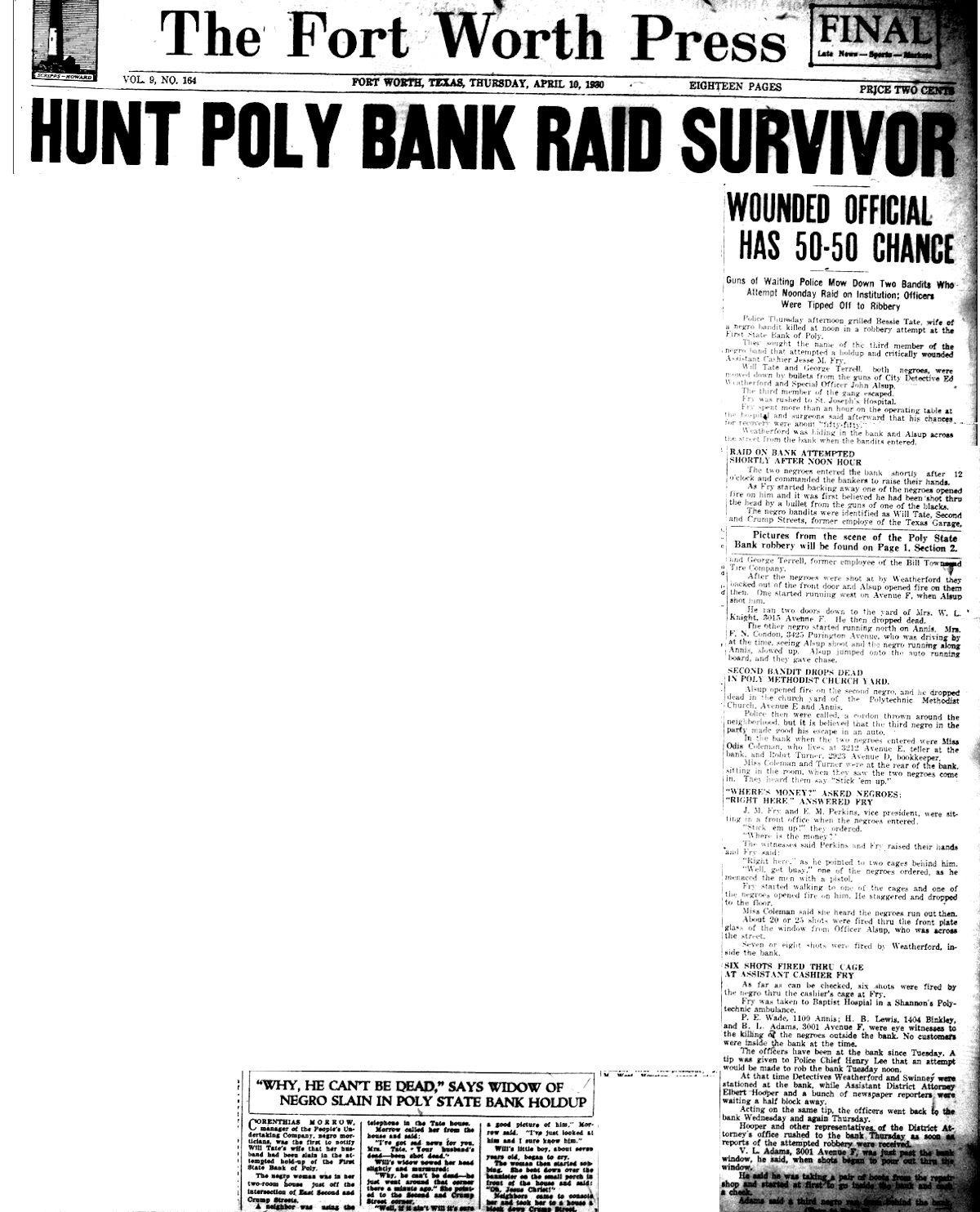
 Front pages of the Press and Star-Telegram on April 10.
Front pages of the Press and Star-Telegram on April 10.
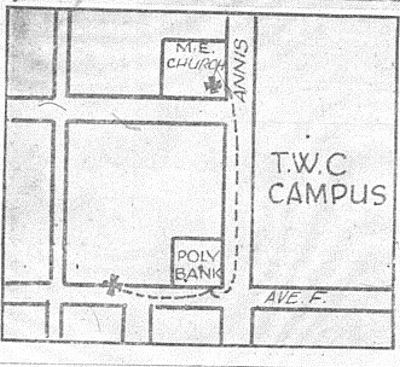 The April 10 Press published a map of the crime scene. Avenue F is now Rosedale Street. Annis Street is now Wesleyan Street.
The April 10 Press published a map of the crime scene. Avenue F is now Rosedale Street. Annis Street is now Wesleyan Street.
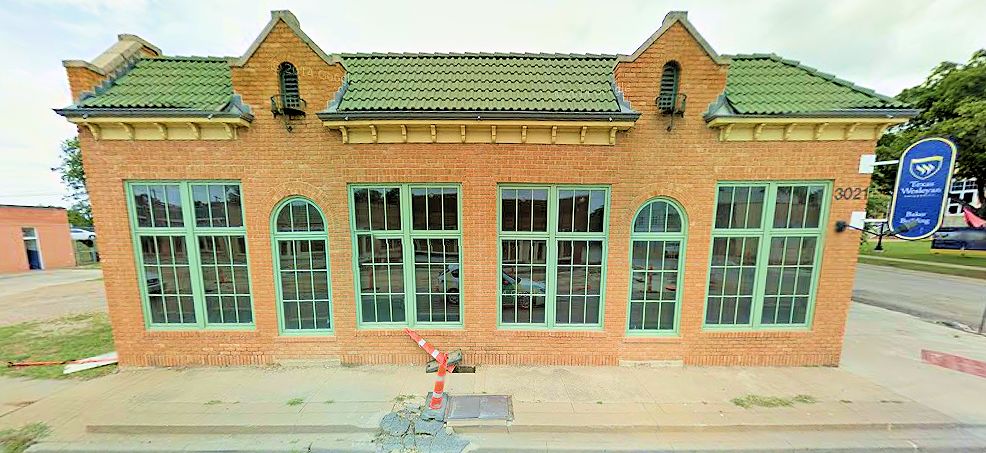 The bank building still stands, now owned by Texas Wesleyan University.
The bank building still stands, now owned by Texas Wesleyan University.
The newspapers on April 10 reported that “special officer” Alsup was helping Fort Worth police in their investigation of the bloody attempted robbery. District Attorney R. A. Stuart said to Alsup, “You started this thing [with your tip], and I think you are the right man to clean it up.”
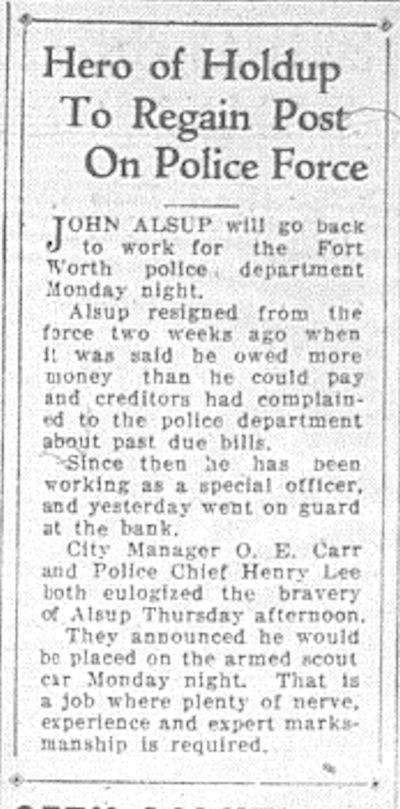 On April 10 the Press reported that Chief Lee would reinstate Alsup. Note that the 1930 census (above) that lists Alsup as a policeman was taken on April 18—shortly after the robbery and his reinstatement as a police officer.
On April 10 the Press reported that Chief Lee would reinstate Alsup. Note that the 1930 census (above) that lists Alsup as a policeman was taken on April 18—shortly after the robbery and his reinstatement as a police officer.
John Frank Alsup had pulled off a picture-perfect crime. Not only was he going to collect the reward money, but also he was being hailed as a hero, and he was back on the police force—and in a position of some status. His new job on the armed scout car required “nerve, experience and expert marksmanship.”
But John Alsup’s reinstatement would be short-lived.
Someone snitched.
 The police began to receive tips indicating that Tate and Terrell had been framed. Police began to look for a scarfaced white man. The face of accomplice Augustus Penn Boyt had been disfigured in an earlier auto accident. Clip is from the April 12 Press.
The police began to receive tips indicating that Tate and Terrell had been framed. Police began to look for a scarfaced white man. The face of accomplice Augustus Penn Boyt had been disfigured in an earlier auto accident. Clip is from the April 12 Press.
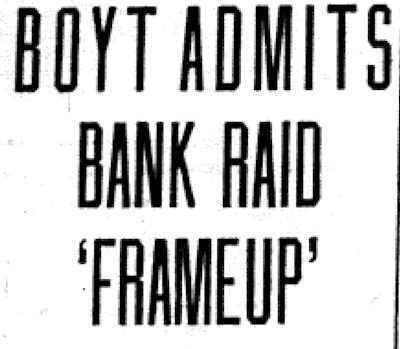 Police questioned Boyt. Boyt talked and walked: Boyt told police that Alsup was the ringleader; Alsup and Boyt were indicted for the murders of Will Tate and George Terrell; Boyt agreed to testify against ringleader Alsup; charges against Boyt were dropped. Clip is from the April 17 Press.
Police questioned Boyt. Boyt talked and walked: Boyt told police that Alsup was the ringleader; Alsup and Boyt were indicted for the murders of Will Tate and George Terrell; Boyt agreed to testify against ringleader Alsup; charges against Boyt were dropped. Clip is from the April 17 Press.
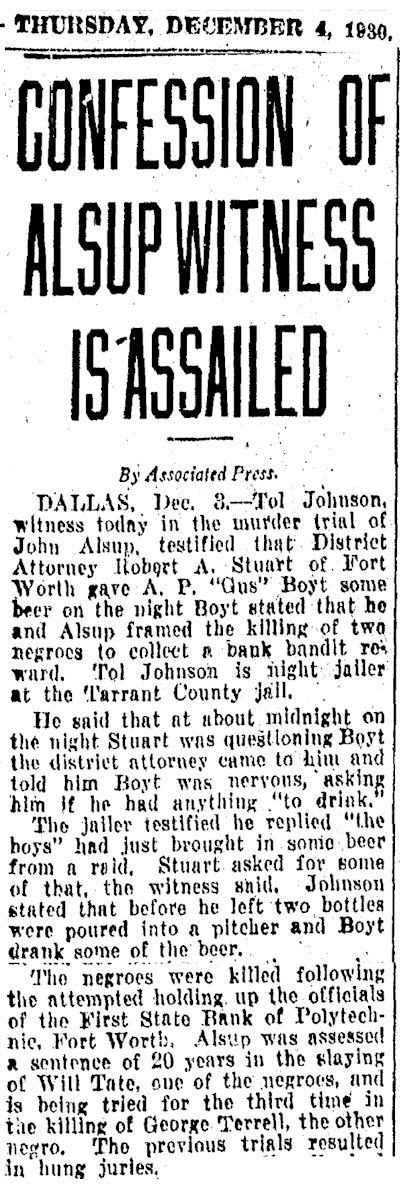
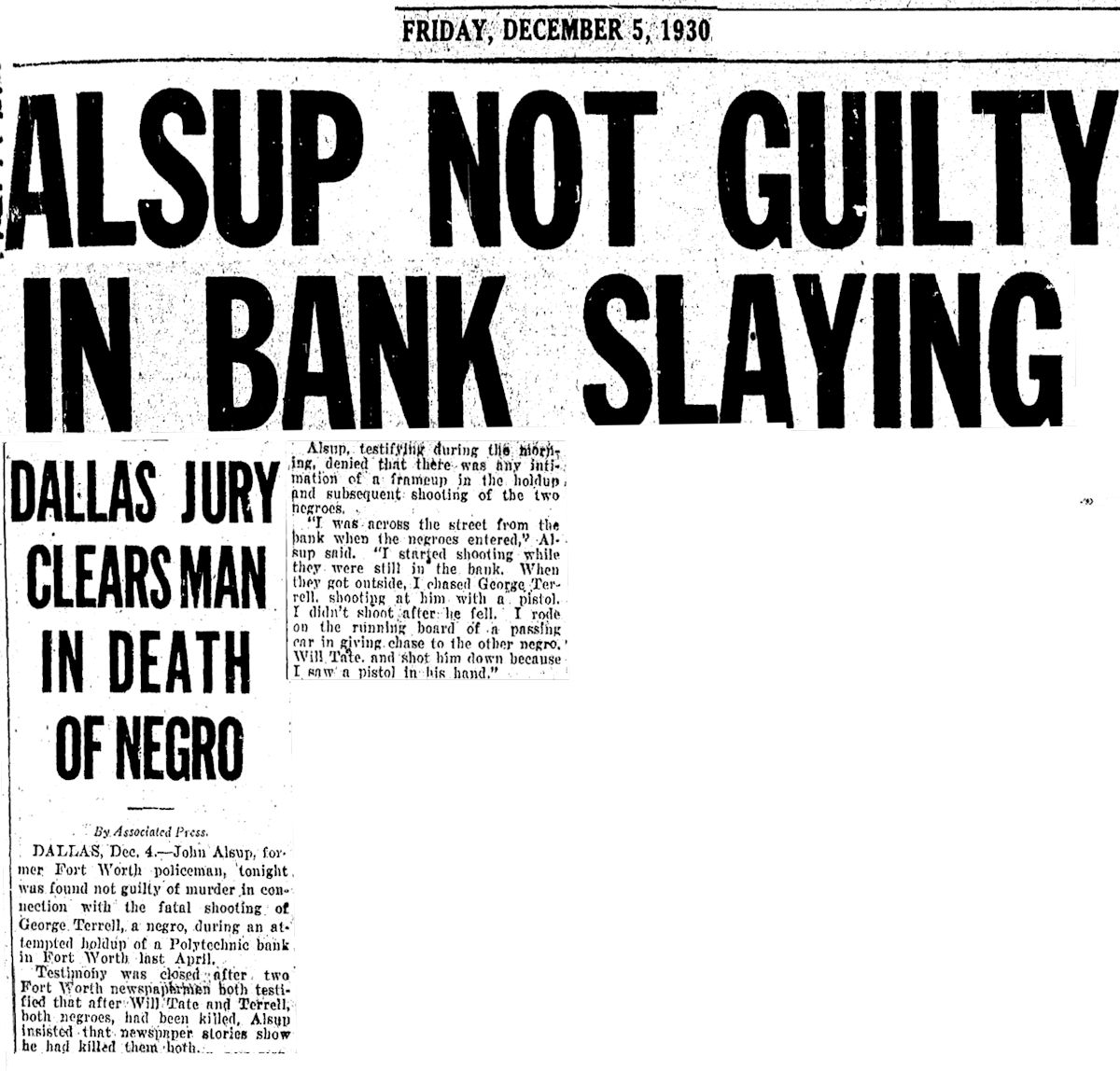
And then began John Frank Alsup’s pinball journey through the legal system: conviction on one charge, acquittal on another charge, appeal, mistrial, change of venue, retrial, and a courtroom tempest created when a witness testified that the prosecution had gotten star witness Boyt drunk in his jail cell. Defendant Alsup could hardly deny having killed the two bank robbers, but he consistently denied having duped them into robbing the bank in order to kill them for the reward. His favorite response to cross-examination by the prosecution was, “No, sir.”
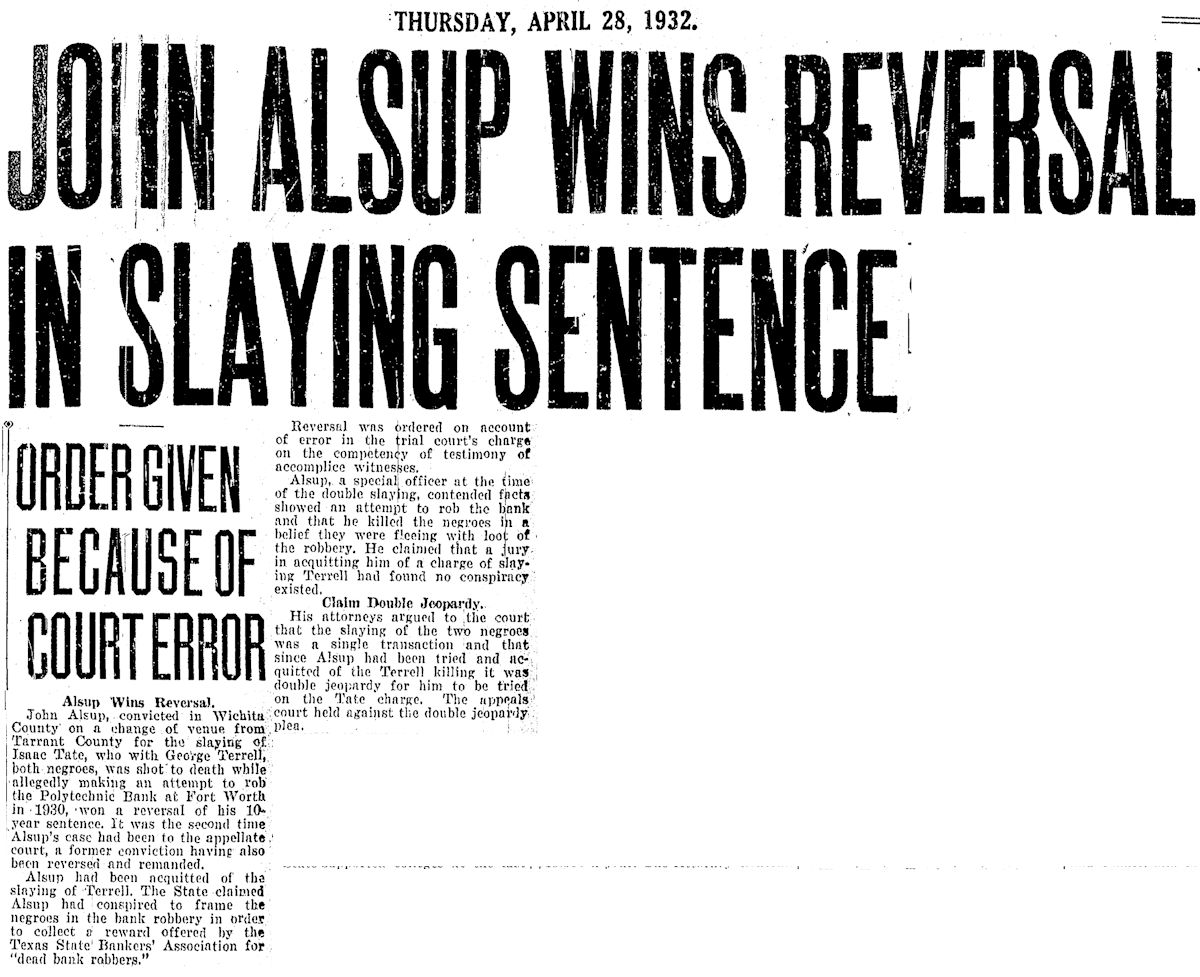
Finally, in 1932, almost two years after his fake robbery fell apart, Alsup’s conviction was reversed. He walked, just as accomplice Boyt had walked.
 After the dust cleared, barber Boyt left town and returned to Hood County, where he had been born in 1889. In 1940 he was caretaker of a cemetery (possibly Tolar Cemetery, where his parents were buried).
After the dust cleared, barber Boyt left town and returned to Hood County, where he had been born in 1889. In 1940 he was caretaker of a cemetery (possibly Tolar Cemetery, where his parents were buried).
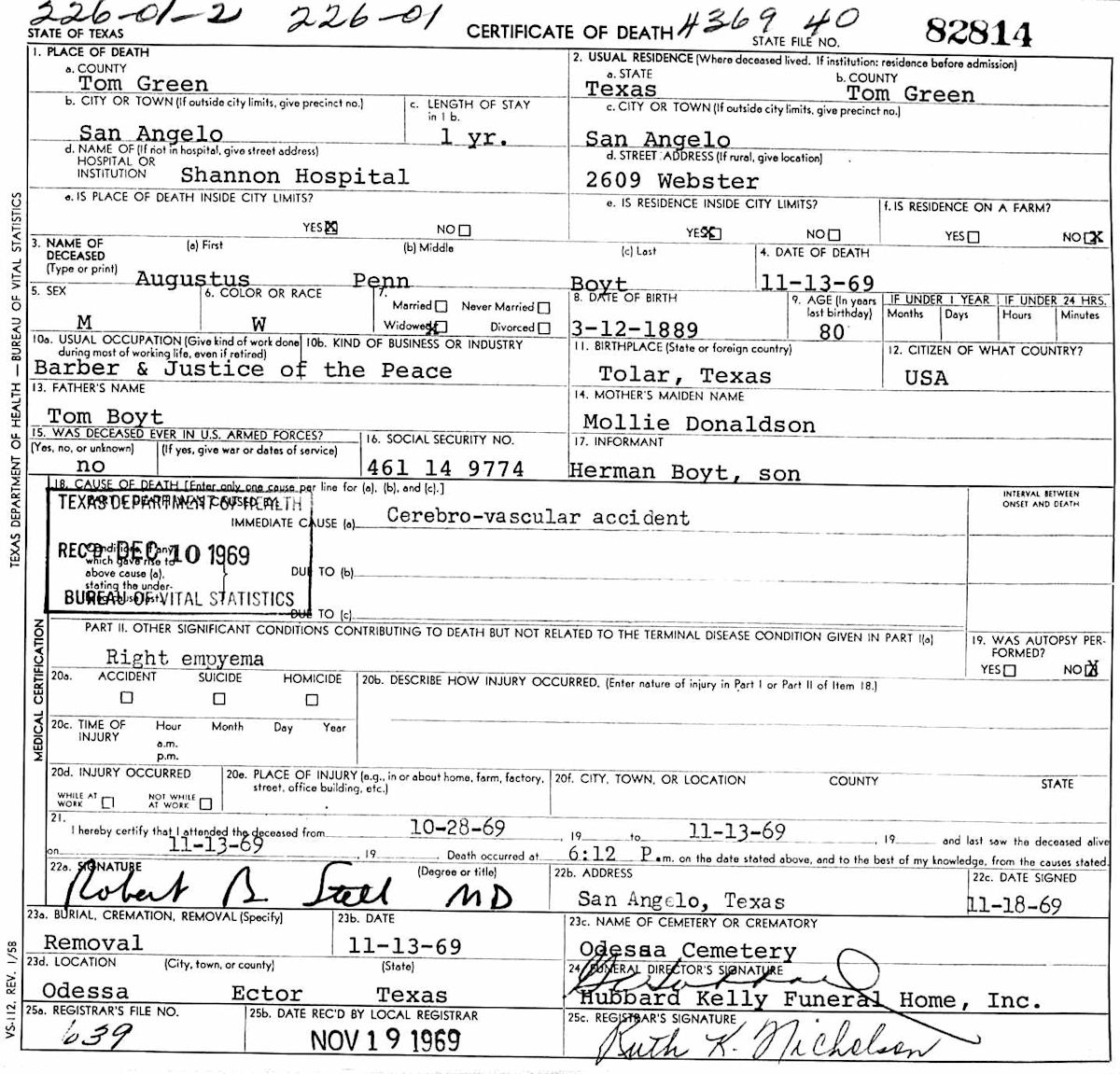 Augustus Penn Boyt died in 1969 and is buried in Ector County. As his death certificate shows, he had later become a justice of the peace.
Augustus Penn Boyt died in 1969 and is buried in Ector County. As his death certificate shows, he had later become a justice of the peace.
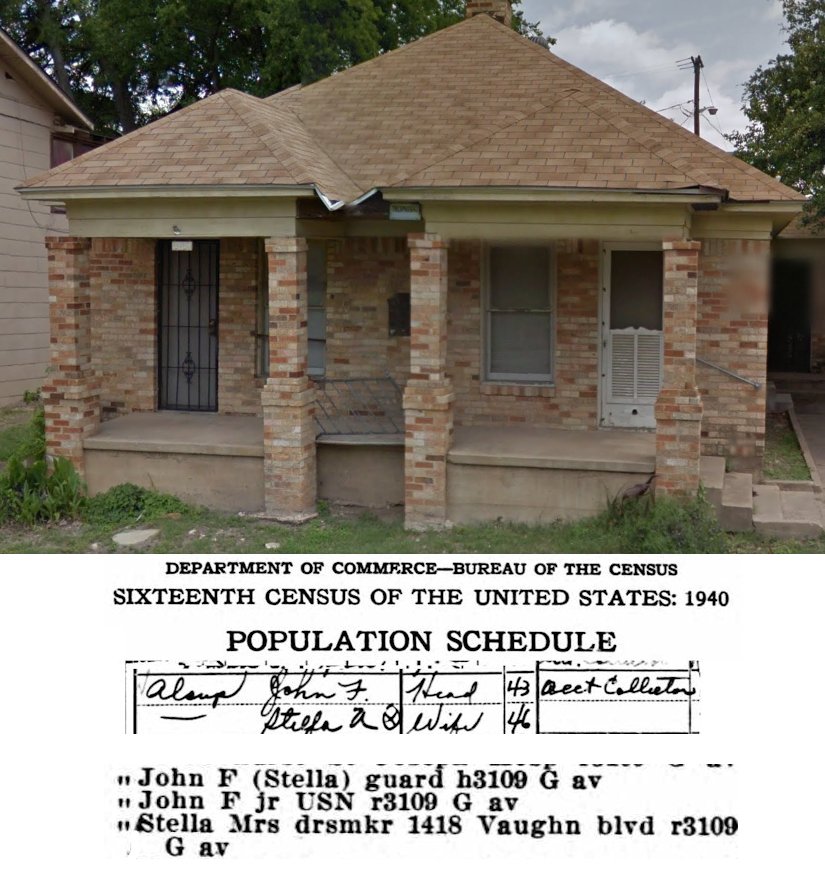 John Frank Alsup remained in Fort Worth, working at various jobs. In 1940 Alsup, who had lost his job on the police force in 1930 “because he couldn’t pay his bills,” was a debt collector. In 1942 he was a “guard” and was living in this much-remodeled house on Avenue G—just one block from the bank and the scene of his 1930 “heroism.”
John Frank Alsup remained in Fort Worth, working at various jobs. In 1940 Alsup, who had lost his job on the police force in 1930 “because he couldn’t pay his bills,” was a debt collector. In 1942 he was a “guard” and was living in this much-remodeled house on Avenue G—just one block from the bank and the scene of his 1930 “heroism.”
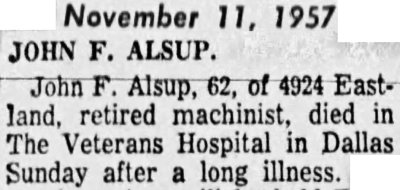
 John Frank Alsup died in 1957 and is buried in Kennedale Cemetery.
John Frank Alsup died in 1957 and is buried in Kennedale Cemetery.
If a tragedy can have a punch line, here it is:
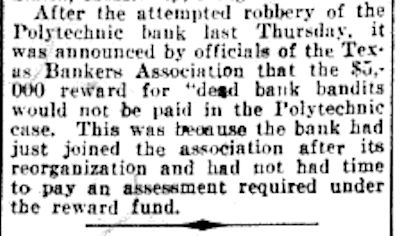 On April 17, 1930 the Star-Telegram reported that the Texas Bankers Association would not have paid Alsup a reward because the robbed bank had not paid its TBA dues. Alsup did all that conniving and took all that risk—and two duped men did all that dying—for nothing.
On April 17, 1930 the Star-Telegram reported that the Texas Bankers Association would not have paid Alsup a reward because the robbed bank had not paid its TBA dues. Alsup did all that conniving and took all that risk—and two duped men did all that dying—for nothing.
(Thanks to retired Fort Worth police sergeant and historian Kevin Foster for the tip.)






Really good story/tale. Thanks for the work in researching and sharing.
Thanks, Paula. You can’t make up stuff like that.
great story tellin’
Thanks. Amazing incident.